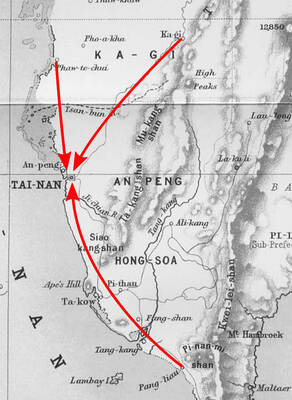The Taiwanese and Japanese co-production Tea Fight (?茶), actor and theater director Wang Ye-min's (王也民) film directorial debut, opened in Japan last month.
The film's draws are readily apparent, as are its shortcomings. Tea Fight features Nippon's favorite Taiwanese heartthrob, Vic Chou (周渝民) of F4, and teen idol Erika Toda starring in a comically convoluted drama about the two countries' tea cultures. The production lacks cohesion as Wang employed an overly theatrical rather than cinematic approach, with artificial lighting and acting techniques taken straight from the stage.
The film opens with a once-upon-a-time story set in the Song Dynasty and two groups of thriving tea-makers: a bellicose male Black Tea Tribe and a peace-loving female Black Tea Tribe.
The two groups had kept to themselves merrily producing black tea until a male Japanese apprentice from the female side provokes the members of the other group by taunting them about the quality of their tea. In response, the male tea tribe massacres the female tribe and destroys its tea plantations.
Fast-forward to present-day Kyoto, Japan, and Yagi (Teruyuki Kagawa), a descendent of the Japanese apprentice, closes down his tea shop after his wife's death, which he believes was caused by a curse invoked by his forefather.
Anxious to help her father get back on his feet, Yagi's teenage daughter Mikiko (Erika Toda) sets out on a journey to Taiwan to find a descendent of the male tribe after she learns that the only way to break the curse is to beat him in a tea-making competition.
Meanwhile, in Taipei, Yang (Vic Chou, 周渝民) is the ruthless kingpin of an underground tea market and a descendent of the male tea tribe who schemes against Ruhua (Chang Chun-nin, 張鈞甯), a descendent of a member of the female tea tribe who miraculously escaped the massacre. Yagi follows his daughter to Taipei to protect her.
The denouement doesn't come a moment too soon, when the four meet in what the director probably intended to be a climatic tea-making competition that forces the participants to confront the demons in their hearts. No one wins. The credits roll.
Tea Fight begins with a promising premise that draws elements from the perennial motif of food-making competitions abundant in Japanese comics and animations, and the tale about ancient China is fertile ground for fantasy. The first half of the film looks set to blossom as an attractive commercial flick, as the story about Yagi and Mikiko unfolds in the manner of a J-pop soap opera. However, when the action switches to Taiwan the film loses focus, as it is told through a series of vignettes strung together not by a strong narrative but for visual entertainment. A theatrically lit illegal tea-trading den looks like a stage set, and several sequences have pantomime acting accompanied by voice-overs.
Standing squarely in the spotlight is the blue-haired Vic Chou, who looks like a kitsch computer-game character and delivers the narrow range of emotional expressions that gives pop idols-turned-actors a bad name.
But perhaps not everything is for naught. With scenes of verdant tea plantations and shots of Japan and China, the film may serve some purpose in promoting tourism.

The Taipei Times last week reported that the rising share of seniors in the population is reshaping the nation’s housing markets. According to data from the Ministry of the Interior, about 850,000 residences were occupied by elderly people in the first quarter, including 655,000 that housed only one resident. H&B Realty chief researcher Jessica Hsu (徐佳馨), quoted in the article, said that there is rising demand for elderly-friendly housing, including units with elevators, barrier-free layouts and proximity to healthcare services. Hsu and others cited in the article highlighted the changing family residential dynamics, as children no longer live with parents,

It is jarring how differently Taiwan’s politics is portrayed in the international press compared to the local Chinese-language press. Viewed from abroad, Taiwan is seen as a geopolitical hotspot, or “The Most Dangerous Place on Earth,” as the Economist once blazoned across their cover. Meanwhile, tasked with facing down those existential threats, Taiwan’s leaders are dying their hair pink. These include former president Tsai Ing-wen (蔡英文), Vice President Hsiao Bi-khim (蕭美琴) and Kaohsiung Mayor Chen Chi-mai (陳其邁), among others. They are demonstrating what big fans they are of South Korean K-pop sensations Blackpink ahead of their concerts this weekend in Kaohsiung.

Taiwan is one of the world’s greatest per-capita consumers of seafood. Whereas the average human is thought to eat around 20kg of seafood per year, each Taiwanese gets through 27kg to 35kg of ocean delicacies annually, depending on which source you find most credible. Given the ubiquity of dishes like oyster omelet (蚵仔煎) and milkfish soup (虱目魚湯), the higher estimate may well be correct. By global standards, let alone local consumption patterns, I’m not much of a seafood fan. It’s not just a matter of taste, although that’s part of it. What I’ve read about the environmental impact of the

Oct 20 to Oct 26 After a day of fighting, the Japanese Army’s Second Division was resting when a curious delegation of two Scotsmen and 19 Taiwanese approached their camp. It was Oct. 20, 1895, and the troops had reached Taiye Village (太爺庄) in today’s Hunei District (湖內), Kaohsiung, just 10km away from their final target of Tainan. Led by Presbyterian missionaries Thomas Barclay and Duncan Ferguson, the group informed the Japanese that resistance leader Liu Yung-fu (劉永福) had fled to China the previous night, leaving his Black Flag Army fighters behind and the city in chaos. On behalf of the